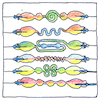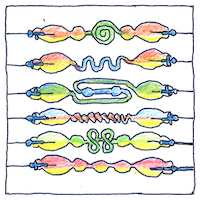Heinrich Geißler
electromagnetism

|
Geissler tube
Heinrich Geißler showed how to make low-pressure glass tubes with platinum wires sealed at each end bent in any path containing a rarefied gas across which a voltage induces an electric flow charging the gas to discharge light in many colors for the novelty electrical entertainment
Increasing vacuum
Benjamin Franklin, William Snow Harris, and Michael Faraday had described electric sparks and lightning conducted by air and Faraday described the appearance of sparks in different gases. In 1858 Faraday pumped air from a glass tube, applied an electric voltage from the cathode at one end to the anode at the other and observed, connecting cathode to anode, a strange glowing arc. The Geissler tube is the same as the Faraday tube except that Geißler had made a better mercury vacuum pump so his tubes generated less heat and more light. In 1869, when Johann Wilhelm Hittorf produced a better vacuum, no light was generated except on the wall opposite to the cathode where cathode rays caused the glass to fluoresce. After William Crookes improved the vacuum even more, in 1897 J. J. Thomson weighed the cathode rays to show that they were not electrically charged atoms but a new particle, electrons.
Various tubes
The Geissler tube was a predecessor of electronic vacuum tubes, cathode-ray and X-ray tubes, oscilloscopes, televisions, xenon flash and xenon arc lamps, sodium and mercury vapor lamps, fluorescent lights, and neon signs.



William Whewell coined the terms cathode and anode for Michael Faraday for his paper on electrolysis in 1834.
The Geissler tube led to the discovery of the electron and the development of electronic devices—computer, radar, radio, television.
See also in The book of science:
Readings in wikipedia:
Other readings: